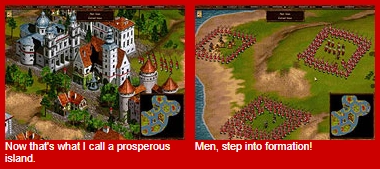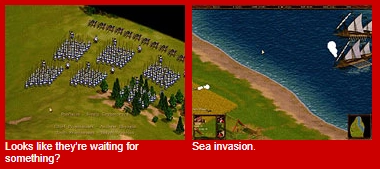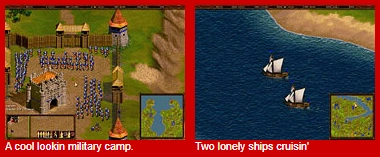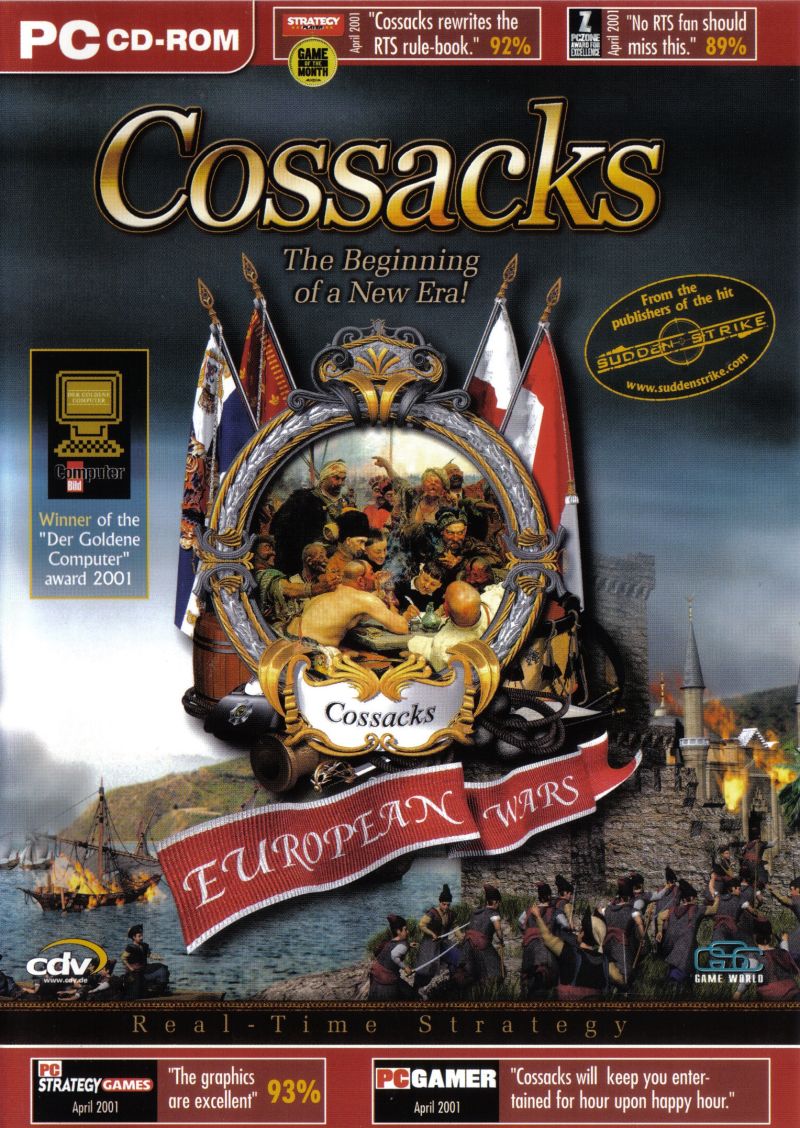

I am quite sure that the sun will rise tomorrow. It hadn’t failed me for more than twenty years, and as there are no significant prophecies that would foretell the end of the world in the next 24 hours, I doubt anyone can deny my last statement. Still, as eternity presents quite a lot of time, I doubt not that there will be a moment when sun will fail to appear in the skies. By the same analogy, the rule that nothing can escape the cruel hand of time can be applied to the gaming industry as well. And if you consider the analogy improper, Think of the bright stars of the gaming industry such as Homeworld, Civilization and Counter Strike or maybe even Sims. Back to the subject – I am quite sure that Age Of Kings, Red Alert (2) and Starcraft will remain the symbols of RTS games for years to come.
Fortunately, my vision of reality (which our EIC tend to refer to as pessimism) does not discourage other programmers to give their best shot at making good games and try some other job with less competition (like selling donuts in front of a police station). CDV SOFTWARE ENTERTAINMENT sets a good example to all restless programmers who would gladly depose the aforementioned games from their throne. Their Sudden Strike lacked only a couple of minor details to reach the top, and their new RTS Cossacks: The European War is even one step closer, but unfortunately, in spite of all its qualities, I doubt that this game will achieve the full success it deserves.
Cossacks depicts the turbulent period in Europe from 16th to 18th century through a dozen campaigns: the Northern War, The War Of Spanish Succession, war for independence of Ukraine, Thirty Year War and the expansion of the tsarist Russia. European history has been used a lot in recent games but I doubt that this event-abundant period will be used to full extent in near future. The given scenarios are interesting both for Europeans and other gamers.

The standard control method used in most 2D RTSs, has successfully been implemented here. Gathering resources, researching technologies, building military bases, recruiting soldiers and waging wars still present the key to success, just like we’re used to. Still, many of these elements have been implemented in rather a peculiar way. The microeconomic element is far more complex than it is in similar games. Apart from food, stone and wood, you’ll have to gather coal iron and gold in order to overpower your opponents. OK, this is a bit more demanding and complex, but it’s nothing really new. Now, the way you spend the resources is. When you create a unit, it will spend certain quantity of food, and more advanced units will even spend gold. The more soldiers you have the faster will your wallet and barns become empty. This basically means that, just like in real life, only rich and economically solid forces can support a large standing army for longer periods of time. Then, quite unlike John Rambo and similar characters, the soldiers in Cossacks require ammo. This means that every single gunshot be it from a handgun or a cannon will spend a certain quantity of coal and iron from your stores. This may seem a bit unrealistic, but it does make sense in a long run, and it will sure prevent you from wasting your ammo senselessly. All this makes the game more complex and shifts the focus from piling up units and rushing the enemy to careful planning and micro-economy. However, I must emphasize that maintaining a healthy economy seems far more difficult than it actually is, as you can well rely on the well-done AI routines of your peasants, which will take care of the tedious things like rebuilding farms or organizing resource transport.
The combat model is far improved and a bit more complex than the usual one. There are five basic types of units: infantry, cavalry, artillery, navy and supply. You will have a chance to command about 50 different military units, and each historical period and nation has its own specific units. I would also like to mention the great information system, which will enable you to see the detailed stats for all your units without having to switch to a help menu or anything like that. Troop manipulation has been much simplified by introducing several specialized options.

The one thing that makes Cossacks stick out of the sea of RTS’s is the detailed tactical element. Warfare logic used to be much different three or four centuries ago. I am not sure anyone could imagine thousands of soldiers slowly and orderly advancing towards enemy lines nowadays. Was it a matter of honor or plain blatant stupidity (Yeah, the whole concept is a mystery to me as well – Ed)? It still seems incredible that none of them had the urge to run or duck or find a shelter (They’d probably get shot by their own, and that’s always a good incentive not to run – Ed). Whatever the case, many books have been written on this type of warfare and CDV SOFTWARE ENTERTAINMENT programmers successfully brought it to life. The encyclopedia (justified name for the help system) which ships with the game contains detailed information on the importance of combining different types of units in action and possible solutions for conquering or defending strongholds, and one of the best tutorials I have ever seen will give you a chance to try out everything you have learned from the encyclopedia. Officers who are essential for organizing soldiers into troops play the key role in battle. Not all officers are equally capable, the higher-ranking ones will be able to command larger number of soldiers and be more efficient at it. Forcing you to use your brain in a war sim. apart from just rapidly clicking around, Cossacks somehow merged classical with tactical RTS games. If I remember well, Fields Of Glory was one of the first games that focused strongly on the tactical element as it only gave you a predetermined number of soldiers at the beginning of each mission with no possibility to summon reinforcements. The goal was to present the atmosphere of spectacular battles where there can be no draws. The general could only rely on terrain analysis, and its proper use. Cossacks has all these elements combined with the micro-economy and development from classical RTS games.
The best thing here is the game engine, which theoretically supports up to 8000 units per battle. I wasn’t able to try this out, but even the first missions showed off this capability of this engine. The programmers used all their experience from Sudden Strike, which was also able to use a lot of units on a map and made an even more powerful engine. The small in size characters have been replaced by relatively big ones, so you won’t have to worry that you mistakenly selected a wrong unit. No player will remain indifferent towards the multitude of rotting corpses, smoke from burning buildings, charging cavalry, naval support, and sounds of drums.

I mostly accounted for the main trumps of the game, but we shouldn’t forget other aspects of it, which have also been well devised. There are a lot of buildings, they look good and are pretty big, but cannot be compared to the ones in AOK. Their names are self-explanatory, and when you destroy them, their ruins will remain on the map. You can also set fire to your own buildings, which can prove to be very useful both when retreating and in sabotage.
The unavoidable tech-tree is that big that you will rarely ever get to research all technologies in one session. All technologies are easily accessible and come with detailed explanations of all they do.
If I would just stop now, Cossacks would turn out to be one of those perfect games, but several flaws, unfortunately, hinder this. First, your computer opponents will frequently use the rushing tactics, thus simply annulling all conceptual advances this game brought. Rapid production of small, cheap kamikaze units and using them to attack fewer far more powerful units still works. I guess this kills all need for subtle tactics in the game. Even beside this, enemy AI is far from perfect and will sometimes react slowly, if at all. Another minus is the too easy procedure for capturing enemy buildings. One soldier coming close to a undefended building is all it takes. This last remark is quite subjective, though, as I gues some players will like this feature.
The graphics are precise and detailed, and as all units are in 2D, you won’t need too powerful a machine to make things go smooth. The game supports all resolutions up to 2048×1536 so, if you have a screen that supports this resolution, then, well, I guess you’re lucky to have a screen that can support a resolution like that.

Sound and music could not be called a masterpiece, but they are good enough to depict the period and events they should.
Multiplayer has been given full attention. Some campaigns and historical battles can only be played against live opponents over the Internet, serial cable or LAN. I did not try this, but some players complained that larger number of units can slow the multiplayer game down way too much. I am sure this can be solved in the future patches, and while you await those, you can practice your skills on the four single-player campaigns and the 26 skirmish maps.
Frankly, I liked Cossacks more than Age Of Kings, which it resembles most. Combining two RTS sub-genres was a bull’s-eye. Still, the gaming population will not accept this unanimously. Some will like the increased complexity and find all they need in this game, while others might get lost in the multitude of stats, units and options and simply give the whole thing a miss. The downsides I enumerated significantly affect playability, but the rest only shows that these programmers know what they are doing and that we should take their future projects seriously.


INFORMATION ABOUT THIS CONTENT:
Originally posted: ActionTrip.com (LINK) (ARCHIVED-1) (ARCHIVED-2)
Date of publish: 20.04.2001
Author: Nikola “Bunny” Zakic
Language of publish: english